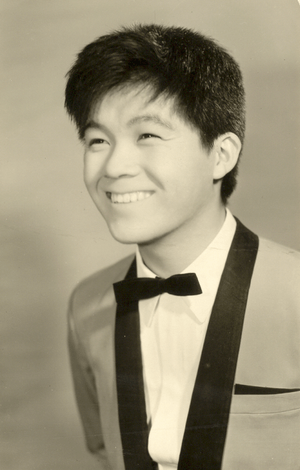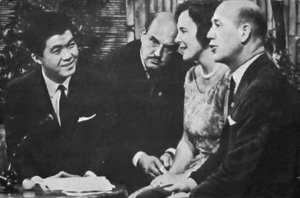Kyu Sakamoto facts for kids
Quick facts for kids
Kyu Sakamoto
|
|||||
|---|---|---|---|---|---|
| 坂本 九 | |||||

Sakamoto in 1961/1962
|
|||||
| Born |
Hisashi Sakamoto (坂本 九, Sakamoto Hisashi)
10 December 1941 |
||||
| Died | 12 August 1985 (aged 43) Mount Takamagahara
Ueno, Gunma, Japan |
||||
| Other names | Kyū-chan | ||||
| Occupation |
|
||||
| Spouse(s) |
Yukiko Kashiwagi
(m. 1971) |
||||
| Children | Hanako Maiko |
||||
| Musical career | |||||
| Genres |
|
||||
| Instruments |
|
||||
| Years active | 1958–1985 | ||||
| Labels |
|
||||
| Associated acts |
|
||||
| Japanese name | |||||
| Kanji | 坂本 九 | ||||
| Hiragana | さかもと きゅう | ||||
|
|||||
Kyu Sakamoto (born Hisashi Sakamoto, December 10, 1941 – August 12, 1985) was a famous Japanese singer and actor. He is best known for his worldwide hit song "Ue o Muite Arukō," which means "I look up when I walk." Many people know this song by its other name, "Sukiyaki."
This song was sung in Japanese and sold over 13 million copies around the world. It became number one on the American Billboard Hot 100 chart in June 1963. This made Kyu Sakamoto the first Asian artist to have a number one song in the United States. He was also the first Japanese artist to have a number one song in Australia. Sadly, Kyu Sakamoto died on August 12, 1985, in a plane crash. He was one of 520 people who died in the accident, which is the deadliest single-aircraft crash in history.
Life and Career
Early Years: 1941–1949
Childhood in Kawasaki and Kasama
Kyu Sakamoto was born on December 10, 1941, in Kawasaki, Kanagawa, Japan. His father, Hiroshi Sakamoto, worked with cargo, and his mother was Iku. Kyu was the youngest of his father's nine children. Because he was the ninth child, he was nicknamed Kyū-chan, which means "lil nine." The name Kyū is also a way to read the Japanese character for his given name, Hisashi.
In the summer of 1944, during World War II, there were many air raids over the Tokyo area. Kyu's mother took her three children to live with their grandparents in the countryside, in Kasama, Ibaraki. They moved back to Kawasaki in 1949. After the war, his father's company closed, and he opened a restaurant.
Teenage Life: 1956–1958
In 1956, Kyu's parents divorced. His mother took care of Kyu and his two siblings, and they all took her maiden name, Ōshima. His older half-siblings kept their father's last name, Sakamoto. Kyu started playing guitar in high school. Soon, he began singing and found he loved it.
First Recordings: 1959–1960
Joining Bands and Becoming a Solo Artist
In May 1958, when Kyu Sakamoto was 16, he joined a Japanese pop band called The Drifters. He wasn't happy as the second singer in the band, which often led to arguments. His big moment with the band came on August 26, 1958, when he sang at a music festival called Western Carnival. After another fight with band members, Kyu left The Drifters in November 1958.
For a short time, Kyu went back to studying and thought about going to university. But in December 1958, he joined a band with his classmate Hisahiko Iida. The band was called Danny Iida and Paradise King. Kyu became their new singer. His singing career started to take off, and he decided to leave school to focus on music. In June 1959, the band signed a record deal with JVC. Their song "Kanashiki Rokujissai" came out in August 1960 and became a big hit. After releasing several popular songs, Kyu Sakamoto got his own record deal with Toshiba Records. He then left Paradise King to start his solo career.
Solo Career: 1961–1985
Debut Album and International Success: 1961–1964
Kyu Sakamoto's solo career began with the love song "Ue o Muite Arukō." It was written by Rokusuke Ei and Hachidai Nakamura. The song was first heard on a Japanese TV show on August 16, 1961. It quickly became a huge hit and was released as a record on October 15. It was the best-selling record in Japan for three months.
His song became famous around the world in 1963. A British record company executive named Louis Benjamin visited Japan and heard the song many times. He decided to take it back to England. Because the original Japanese title was hard for English speakers to say, the song was renamed "Sukiyaki." This new name came from a well-known Japanese beef dish. The name "Sukiyaki" sounded catchy, but it had no real connection to the song's meaning.
First, an instrumental (music without singing) version of "Sukiyaki" by Kenny Ball and His Jazzmen became a hit in England. Then, the original version sung by Kyu Sakamoto was released and also sold very well, reaching sixth place on the charts. In 1963, Capitol Records released the song in the United States. It sold over one million copies and stayed at number one on the Billboard Hot 100 chart for three weeks in June 1963.
After "Ue o Muite Arukō" became a global success, Kyu Sakamoto went on a world tour. This tour lasted from the summer of 1963 to early 1964. He visited countries like the United States, Germany, and Sweden. While in the U.S., he appeared on several TV shows, including The Steve Allen Show. He was also supposed to be on The Ed Sullivan Show, but he couldn't make it because of filming for his movie, Kyu-chan Katana o Nuite.
Kyu Sakamoto had only one other song reach the U.S. charts, "China Nights (Shina no Yoru)," which reached number 58 in 1963. His only American album, Sukiyaki and Other Japanese Hits, reached number 14 on the Billboard Pop Albums chart in 1963. On May 15, 1964, he received a special "Gold Record" award from Capitol Records in Tokyo.
Later Appearances
During the 1964 Summer Olympics in Tokyo, Kyu Sakamoto was on a Swedish TV show called Hylands hörna, which was broadcast live from Japan. In 1968, Kyu Sakamoto and Hachidai Nakamura took part in an international singing contest in Rio de Janeiro. Their song "Sayonara, Sayonara" finished in 7th place.
Marriage and Family
In 1971, Kyu Sakamoto married a Japanese actress named Yukiko Kashiwagi. They had two daughters, Hanako and Maiko.
Death
On August 12, 1985, Kyu Sakamoto was on Japan Air Lines Flight 123. He was flying from Tokyo to Osaka for an event. Sadly, the plane crashed into two mountains in Ueno, Gunma. This accident is known as the deadliest single-aircraft accident in history, with 520 people losing their lives, including Kyu Sakamoto. He was buried at Chōkoku-ji Temple in Tokyo.
Legacy
Kyu Sakamoto's most famous song, "Ue o Muite Arukō" ("I look up when I walk"), is still the only Japanese song to reach number one on the Billboard pop charts in the United States. It stayed at the top for three weeks in 1963. It was also the first Japanese song to enter the Australian charts, where it reached number 2. In the UK, it reached number 6.
"Ue o Muite Arukō" has been covered by many artists over the years. The first cover was an instrumental version by Kenny Ball and his Jazzmen. Other famous English versions include one by A Taste of Honey in 1981 and another by 4 P.M. in 1995. Both of these versions reached the top ten on the Billboard Hot 100. In 1989, Selena released a Spanish version of the Taste of Honey cover. Parts of the English lyrics have also been used in songs by artists like Slick Rick, Doug E. Fresh, Salt-N-Pepa, Snoop Dogg, Bone Thugs-n-Harmony, Raphael Saadiq, Mary J. Blige, and Will Smith.
An American singer named Jewel Akens also made a version with different English lyrics in 1966, called "My First Lonely Night (Sukiyaki)." It reached number 82 on the Billboard Hot 100.
On March 16, 1999, Japan Post released a special stamp to honor Kyu Sakamoto and his song "Ue o Muite Arukō."
Discography
Albums
- Sukiyaki and Other Japanese Hits (1963)
- Very Best of Kyu Sakamoto (1994)
- Kyu Sakamoto Memorial Best (2005)
- Kyu Sakamoto CD & DVD The Best (2005)
Singles
| Year | Title | Peak chart positions |
Record Label | B-side | Album | |||
|---|---|---|---|---|---|---|---|---|
| US Pop |
US AC |
US R&B |
UK | |||||
| 1963 | "Sukiyaki" | 1 | 1 | 18 | 6 | Capitol | "Anoko No Namaewa Nantenkana" | Sukiyaki and Other Japanese Hits |
| "China Nights (Shina No Yoru)" | 58 | 19 | — | — | "Tsun Tsun Bushi (The Tsun Tsun Song)" | |||
| "Miagete Goran Yoru no Hoshi o" | 1 | 1 | 18 | 6 | "Benkyo No Cha Cha Cha" | |||
| 1964 | "The Olympics Song" | — | — | — | — | "Tankobushi" | ||
| "Sayonara Tokyo" | — | — | — | — | "I Like You (Kimiga Suki)" | |||
| 1986 | "Miagete Goran Yoru no Hoshi o" (re-release) | 41 | 41 | 48 | 47 | "Benkyo No Cha Cha Cha" | ||
| "Sayonara Tokyo" (re-release) | — | — | — | — | "I Like You (Kimiga Suki)" | |||
Filmography
- Takekurabe (1955)
- Everything Goes Wrong (1960)
- Kigeki: ekimae danchi (1961)
- Ue o Muite Arukō (1962)
- Shichiji ni aimashō (1963)
- Clap your hands when you are happy (1964)
- Gulliver's Travels Beyond the Moon (1965)
- Kyūchan's Big Dream (1967)
- Tokkan (1975)
Biography
- Ue o Muite Arukō: Sakamoto Kyū Monogatari (made-for-TV movie, TV Tokyo, 2005)
See also
 In Spanish: Kyū Sakamoto para niños
In Spanish: Kyū Sakamoto para niños



